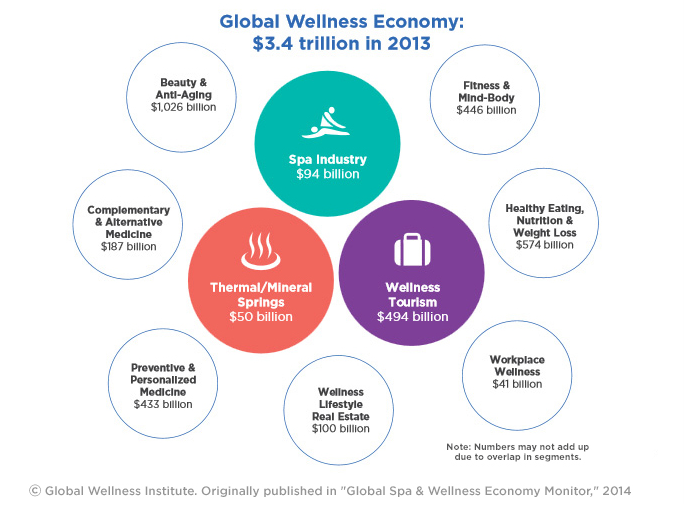Whether you believe the U.S. healthcare system is broken or not, one thing everyone can agree on is the fact that we’re living longer, and being able to extend the quality of life accordingly matters. And while some of us may have considered the financial implications of living beyond a normal life expectancy, an increasing number of Americans are also evaluating what it’s going to take to ensure that living longer includes vitality in mind, body and spirit.
For this, many are shifting to a preventative care mindset, with a total wellness model as their approach. Working from the premise that within our bodies and minds lies an interconnection of all parts, total wellness aims to prevent and treat pain and sickness by integrating care. And that integration, which may involve coordinating conventional with complementary approaches, is a sharp contrast to traditional medicine’s more specific treatment and prevention methods.
But the landscape in the U.S. and globally is rapidly changing.
According to a study published by the Global Wellness Institute in 2013, preventive and personalized medicine contributed $433 billion to the $3.4 trillion total global wellness economy which also includes complementary medicine, workplace wellness, the spa industry, nutrition and weight loss, mind-body fitness and wellness lifestyle real estate among others.

Treating the Whole Person
The most recent major survey of hospitals released by the Health Forum, a subsidiary of the American Hospital Association, and the Samueli Institute of Alexandria, Va., was conducted in 2010. Of the responding hospitals, 42% reported integrating traditional treatment with less conventional approaches to some degree or another, which was up from 37% in 2007. Even more convincing, is that 85% of respondents said that patient demand is what is driving the increase, but at the same time, 75% cited budgetary constraints as an obstacle to expanding collaborative treatment.
So what does all this mean for the dental industry?
Earlier this year the American Dental Association (ADA) released its latest report on the future of dentistry. In it, care coordination and collaboration models are both named among the top five forces and opportunities that will reshape the dental practice environment over the next several years.
Shifts in the healthcare system are certainly influencing patient mix, but in addition to demographic changes, they’re also fueling consumerism. Patients feel more empowered than ever before to shop around for healthcare providers, selecting the ones they believe will offer the best care for their needs, and in the most cost effective way possible. As a result, the ADA predicts team-based care, value-driven models and practice consolidation will grow and the average dentist will see a significant increase in new patient traffic, and new profit centers will emerge.
Yet in spite of a positive outlook for new practice models, integrative dentistry is still a foreign concept to dental patients and to many docs as well.
Integrative Care’s PR Problem
Consumer awareness about the mouth-body connection has increased significantly in the last 15 to 20 years, however, there’s still much work to be done in terms of promotion.
Key findings from the Center for Disease Control and Prevention (CDC) National Health and Nutrition Examination Survey, 2011-2012, were that 91 percent of Americans had dental caries with close to 30 percent going untreated. The CDC’s latest report on periodontal disease revealed that just over 47 percent of the U.S. population have mild, moderate or severe periodontitis. The U.S. Surgeon General called the findings a “silent epidemic”, and issued a national call to action to promote oral health.
For dentists, the implications of this oral “epidemic” should be clear – the overall systemic health of one out of every two American adults is at greater risk, particularly for conditions where there is a working relationship with inflammation such as diabetes, heart disease, as well as certain cancers.
While many dentists view themselves as “gatekeepers” of systemic health, others may not directly assume the responsibility. The question is, “Should they?”
The answer is not as simple. Integration of care is still very much an emerging area across healthcare. And although there’s a steady chorus of support for its benefits and a growing number of patients who are asking for it, the AHA survey of hospitals also found that there are major obstacles to its growth including doctors not getting behind it — possibly because of a lack of understanding — as well as limited funding and research. Teaching hospitals and hospitals in urban areas, however, had a significantly higher likelihood of fostering an environment for integrating care.
As it relates to the dental industry, these PR problems are further compounded by two major factors. In addition to limited awareness, inconsistencies in terminology and approaches to treatment, have likely contributed to misperceptions and often raise questions of credibility.
A Google search of the term “integrative dentistry” produces results on topics ranging from holistic and alternative medicine, to cosmetic dentistry and cancer-causing fillings. It’s a virtual mixed bag of information that goes from the hokey to the downright scary, which may deter many practitioners from exploring credible integrated care philosophies that make sense for their practice. And practically speaking, education and transitioning to a new way of doing things is not always easy.
But bottom line, the real question doctors have is whether or not integrative care has a positive impact on the practice’s bottom line. Rightfully, they want to know, “Is it a viable profit center?”, and the information has not always been readily available.
To get answers to these questions and more, CWA Digital News (DN) reached out to DeWitt Wilkerson, DMD, Director of Dental Medicine at the Dawson Academy in St. Petersburg, Fla., who instructs a course that teaches dentists the benefits of taking a proactive, whole-body approach to care and how to build it into their dental practices.
With regard to terminology and practices, Dr. Wilkerson quickly makes the distinction between an “integrative” approach and treatment that is not based in science. He says that integrative dental practices must uphold the same standard of care. His philosophy and instruction focuses on connecting proven, scientifically-based measures to prevent and treat issues in four main areas where he says there is a natural symbiosis, and therefore should be looked at as a whole. The integration of care is a relationship involving the patient, the dentist and often times a primary care doctor that takes specific and defined issues into account as the care plan is developed and carried out.
The four areas he teaches, and that are emphasized in Dr. Wilkerson’s own practice are what he calls the 4 Bs – BITE, where incoordination not only effects teeth, but can cause muscle soreness and headaches; BACTERIA, the source of infection and inflammation; BREATHING, where airway obstruction side effects and links include sleep apnea, reflux, arrhythmias and high blood pressure; and BODY, which takes into account the relationship between oral health and nutrition, physical activity, stress, and systemic conditions.
Wilkerson’s total wellness approach to dentistry believes that these are areas that naturally start with dentists in their role as “gatekeepers”, and as such provides a unique opportunity to provide even better care.
Additional questions DN put to Wilkerson:
DN: What would you like dentists who may be considering taking a total wellness approach to know?
DW: This is a field that once you’re exposed to it, you get hooked! It will transform your own health, then the health of select patients who have obvious untreated problems, then it broadens to a more general base of everyone you know. Finally, it becomes clear that these important health principles can solve our health care crisis nationally. It is so rewarding to have answers that expand dentistry from simply saving teeth to literally making patients aware that we very well may have saved their lives.
DN: Briefly explain integrative dentistry as a profit center.
DW: As a business model there are multiple sources of revenue within the 4Bs:
For bite: Our office sees revenue from TMJ diagnosis, occlusal splint therapy, occlusal equilibration, and headache/migraine treatment
For Bacteria: Salivary testing, non- surgical periodontal therapy, probiotic sales and antimicrobial sales create additional revenue stream. A “single practitioner” practice we know well now has 3 hygienists and produced $1 million in revenue last year in this practice focus, with many area MDs sending patients to the office for periodontal/heart care.
For Breathing: Revenue from sleep apnea screening, home sleep testing, working closely with local MDs and sleep labs, plus oral appliances have some dentists transitioning full-time in this field. Promising, mutually beneficial relationships are developing between dentists, MDs, and medical insurance carriers. This area has great potential revenue.
For Body – In our practice, screening for systemic inflammation seen in high blood pressure, diabetes, high cholesterol, thyroid, adrenal dysfunction is also where we see additional revenue. We have recently brought in a nutritionist and personal trainer. We sell supplements, probiotics, and are seeing revenue steadily grow in this area as well.
DN: How should doctors market this to both new and existing patients?
DW: I recommend beginning to learn about one of these topics and integrating it into your own lifestyle. Additionally:
• Get the whole staff involved through courses and lunch-and-learns.
• Copy scientific or magazine articles that can be shared with interested patients.
• Train staff to talk with patients about new dental/medical topics in hygiene.
• Begin to offer simple services that make sense.
• Add new topics as they are appreciated by all in the office.
• Routinely ask patients about their whole health and find out how your team might assist them.
There will be patients who are highly educated on many of these topics that will share their experience. And remember, there is much information out there that patients hear about but don’t ever hear discussed by their doctors- they are interested!
DN: What does total wellness training and education for dentists look like? What’s the learning curve?
DW: The learning curve on many of these topics is not difficult. There are several very good teaching centers for these various topics. Many are familiar with Pankey, Kois and Spear for the bite topic, and Dawson offers a course called, Building a Profitable Integrative Dental Medicine Practice. There are other excellent courses on periodontal therapy, sleep apnea and whole health. Attending one of several two-day courses can quickly catch you up on the latest advances and opportunities in each of these areas of focus. I suggest integrating one at a time over a one to two year period. I also recommend checking out the American Academy for Oral Systemic Health (AAOSH), which holds an annual two-day meeting.
DN: What kind of financial investment should a doctor who’s interested expect to make?
DW: Primarily the cost of attending educational courses. Most direct costs of supplies are quickly recouped by patient fees.
For more on courses available through The Dawson Academy, email dwilkerson@dupontwilkerson.com.














